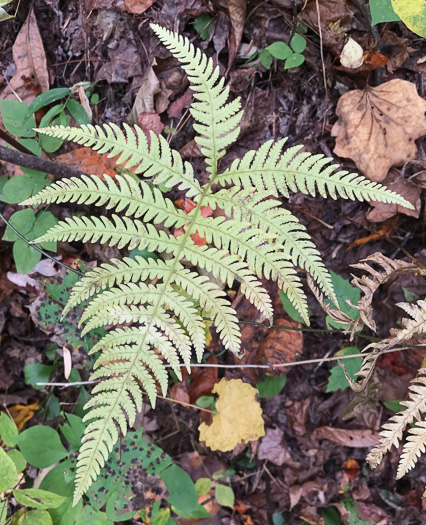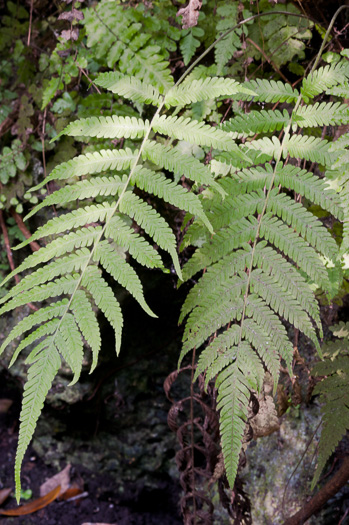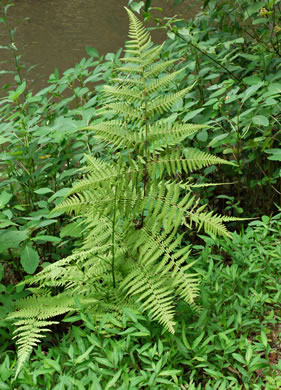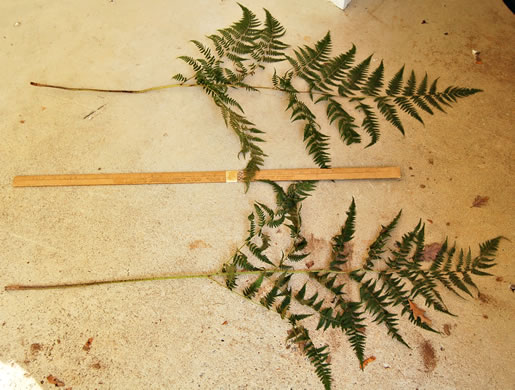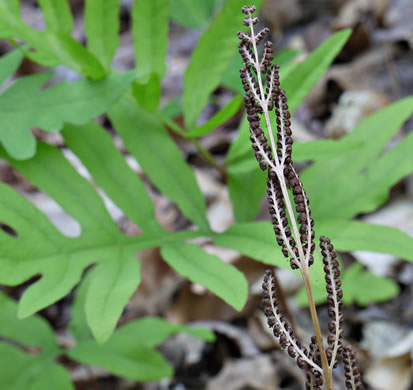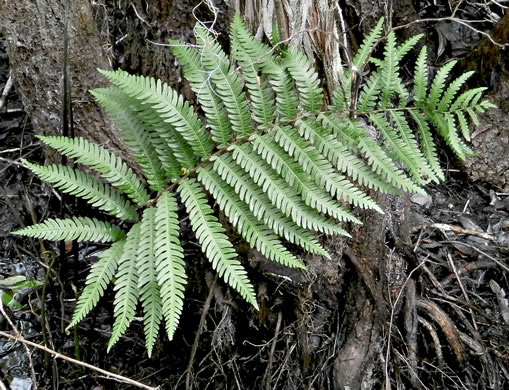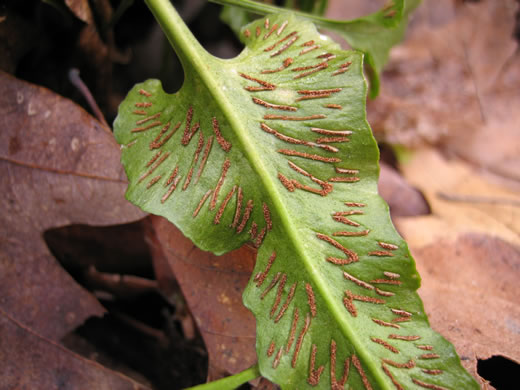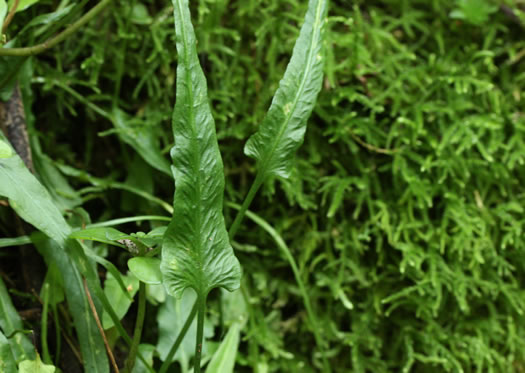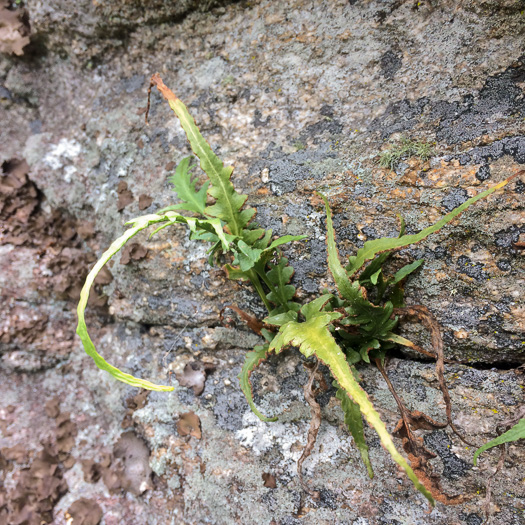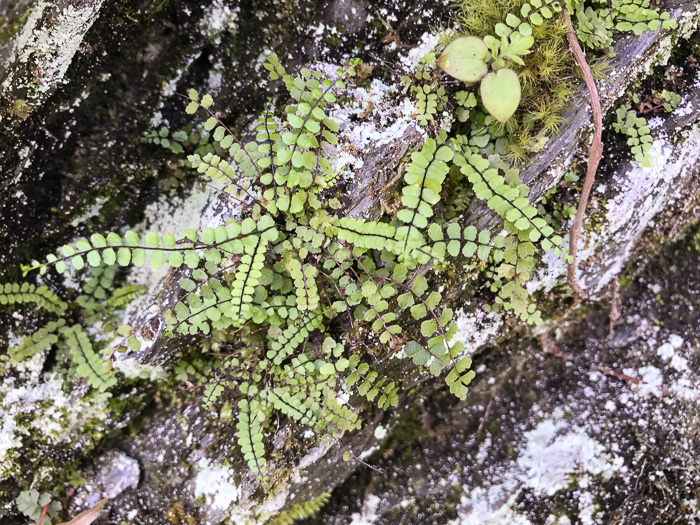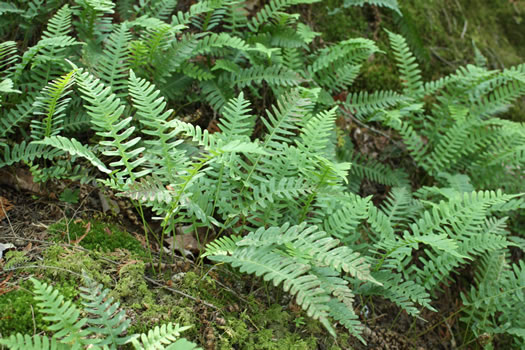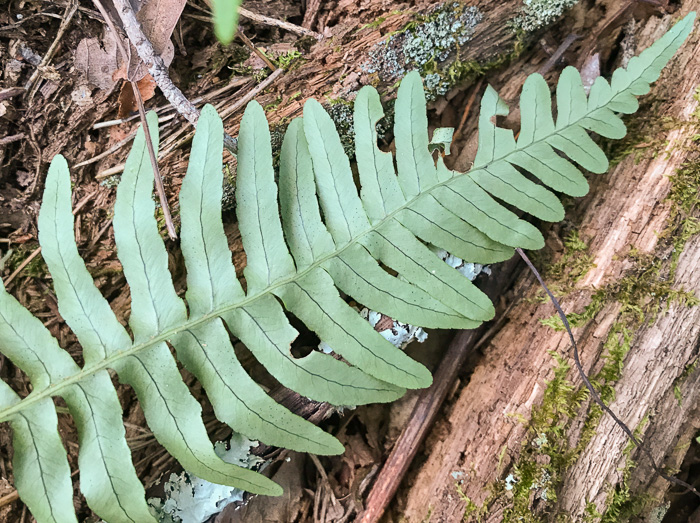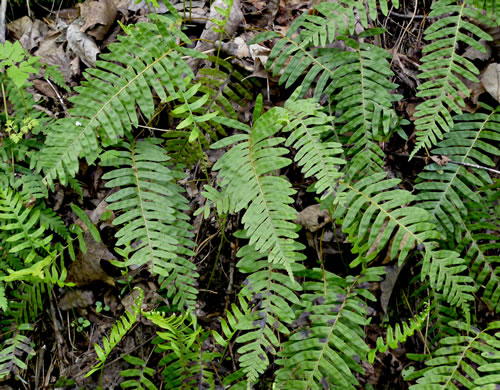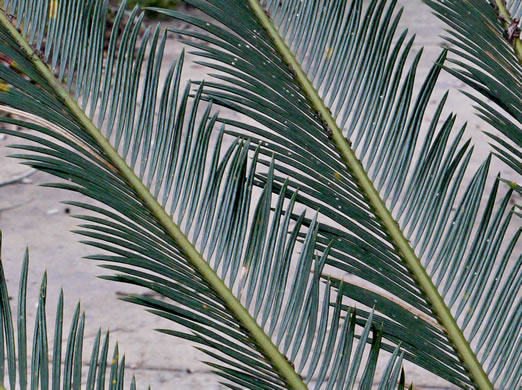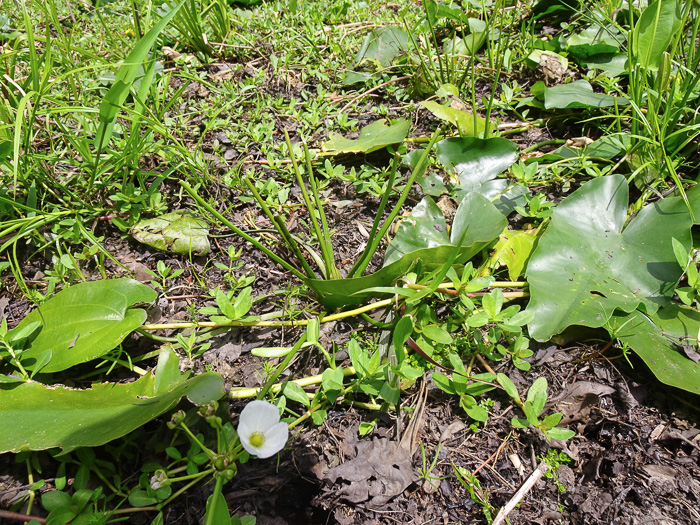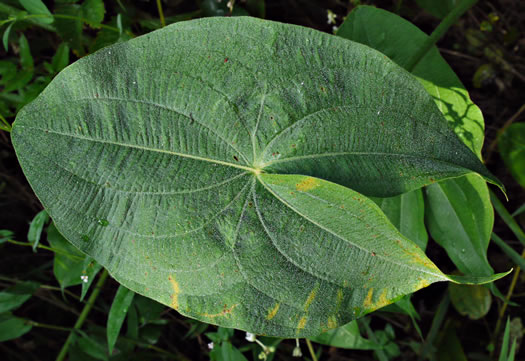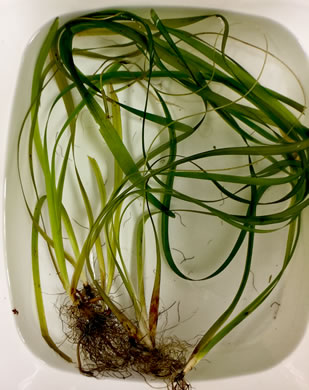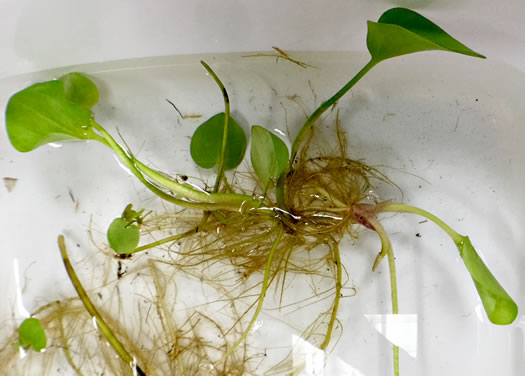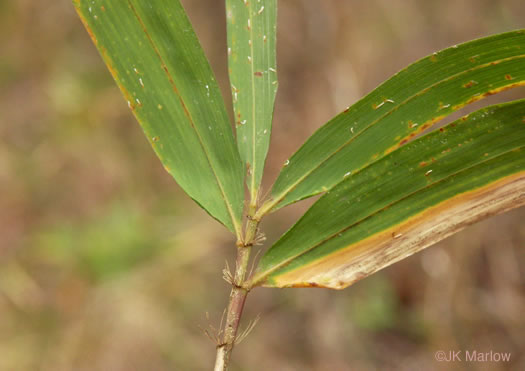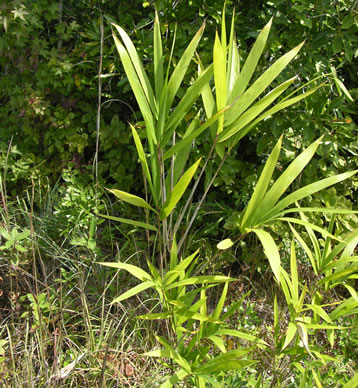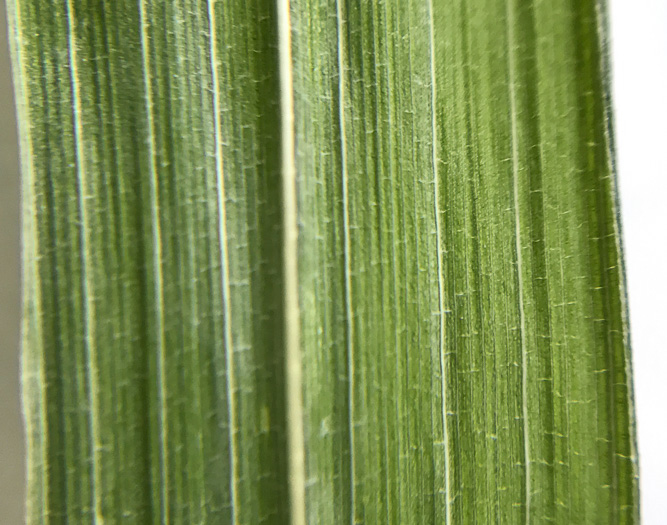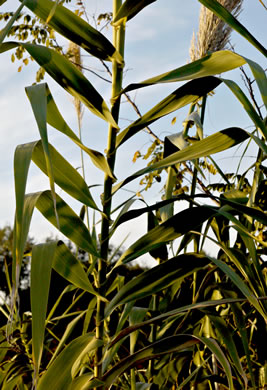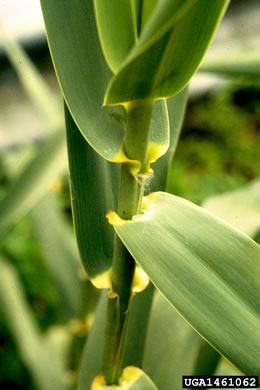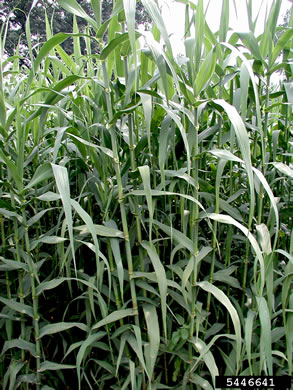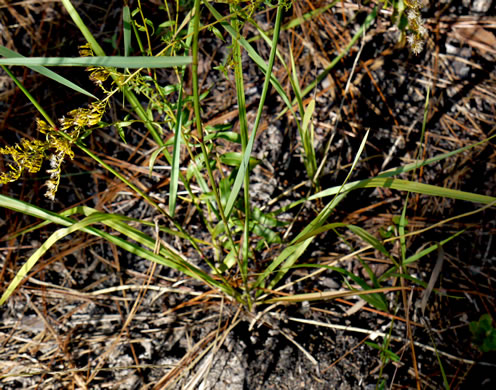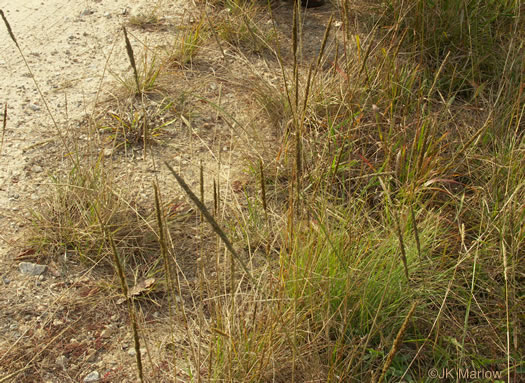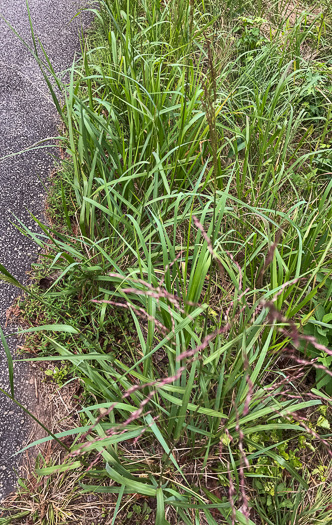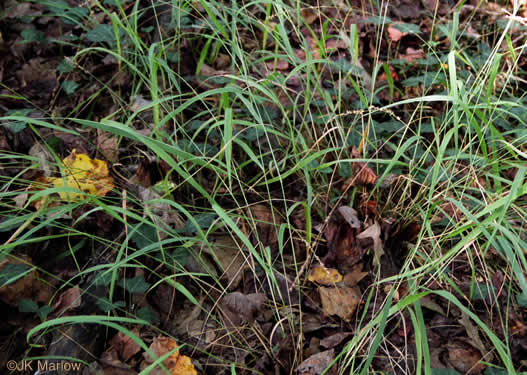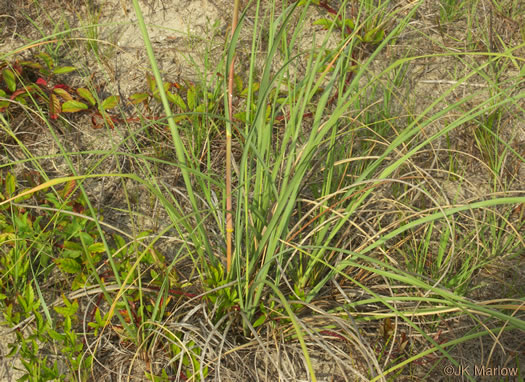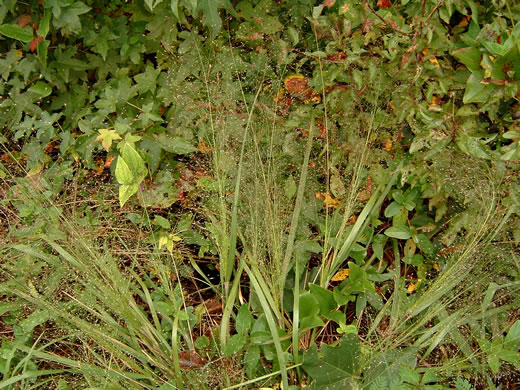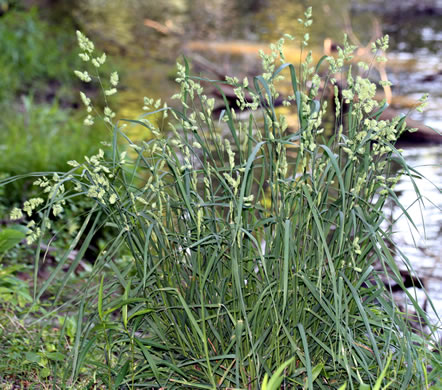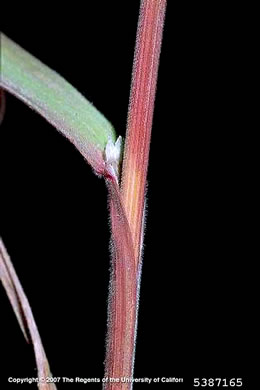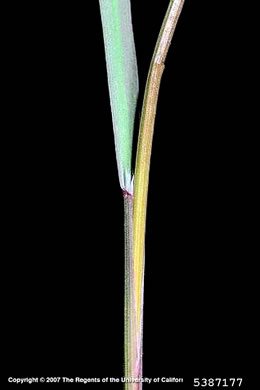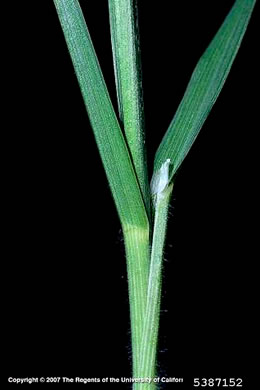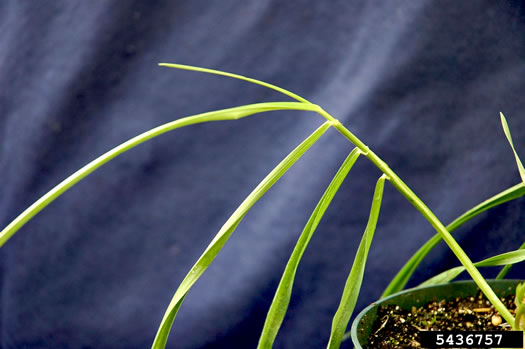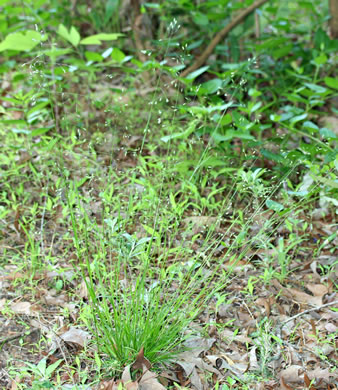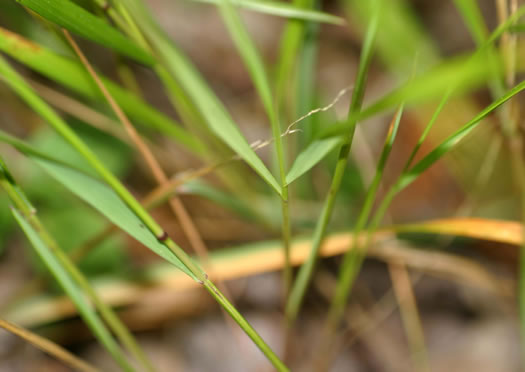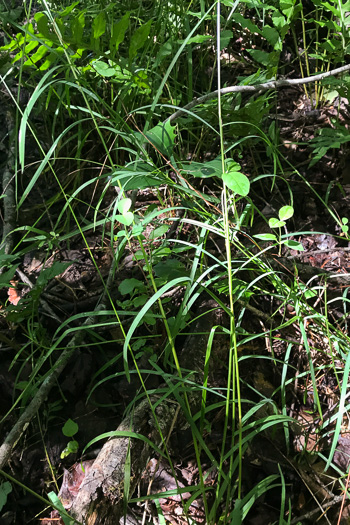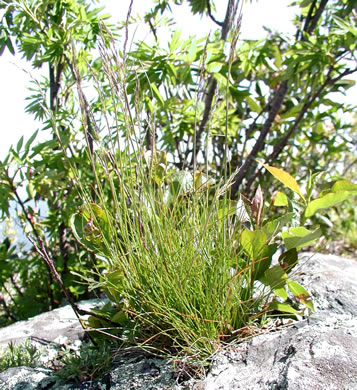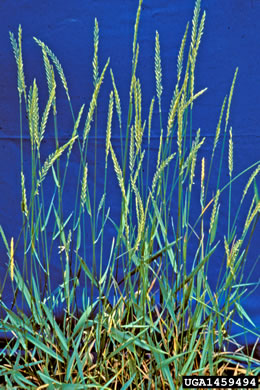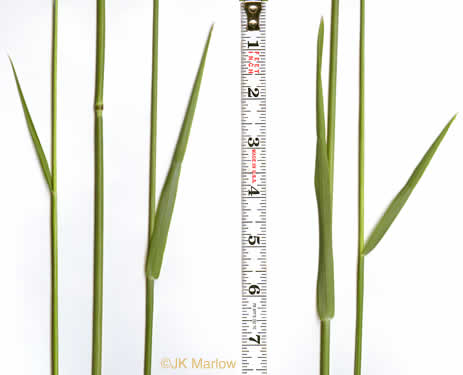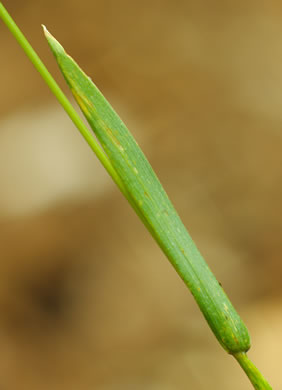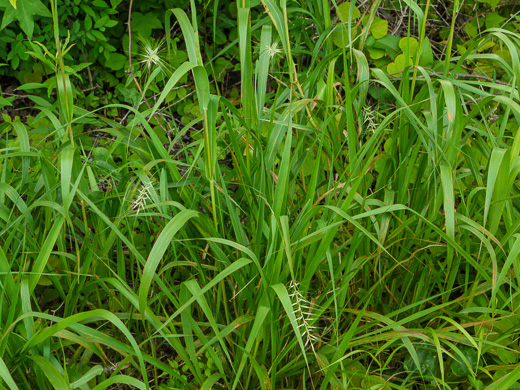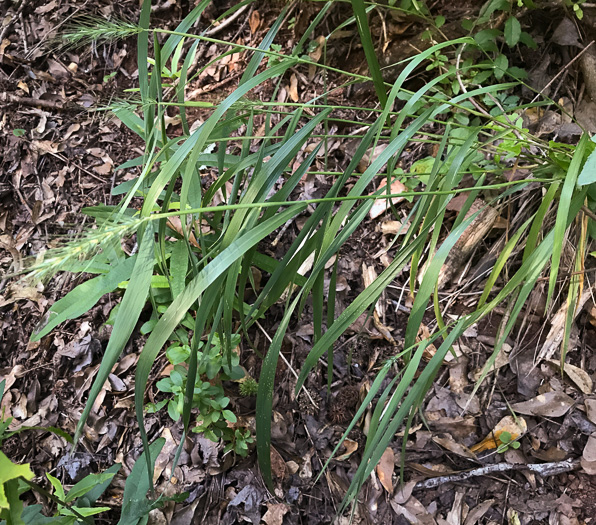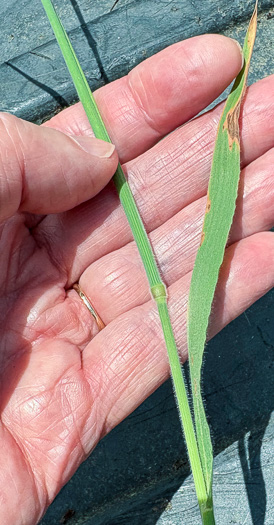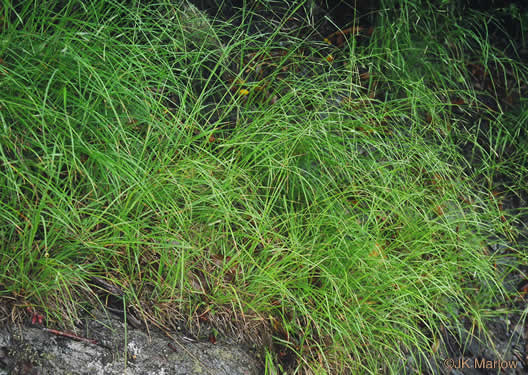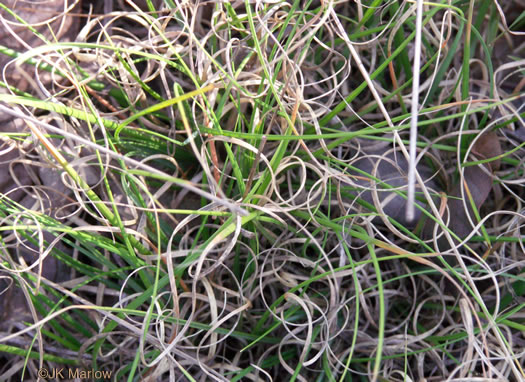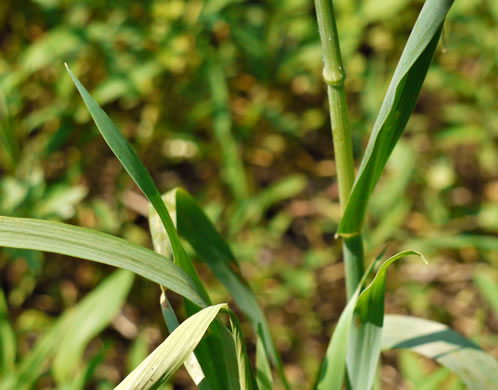Your search found 493 image(s) illustrating the term "blade." For a written explanation, click on "blade" in the Glossary.
PAGE 1 PAGE 2 PAGE 3 PAGE 4 PAGE 5 PAGE 6 PAGE 7 PAGE 8 PAGE 9
To see larger pictures, click or hover over the thumbnails.
To go to the plant's detail page, click its name.
 Broad Beech Fern,
Phegopteris hexagonoptera
Broad Beech Fern,
Phegopteris hexagonoptera
Blade distinctly triangular. Pinnae connected along rachis by winged tissue, per Peterson Field Guide to Ferns of Northeastern and Central North America.
 Kunth's Maiden-fern,
Pelazoneuron kunthii
Kunth's Maiden-fern,
Pelazoneuron kunthii
Blade lanceolate, pinnae long-oblong, both with long tapering tips, per Field Guide to the Ferns and Other Pteridophytes of Georgia (Snyder & Bruce, 1986).
 Downy Maiden-fern,
Christella dentata
Downy Maiden-fern,
Christella dentata
Fronds 40-100cm long; tufted. Blades lanceolate with a long, tapering tip, per Field Guide to the Ferns and Other Pteridophytes of Georgia (Snyder & Bruce, 1986).
 Mariana Maiden-fern,
Macrothelypteris torresiana
Mariana Maiden-fern,
Macrothelypteris torresiana
Blade covered w needlelike hairs, per Field Guide to the Ferns and Other Pteridophytes of Georgia (Snyder & Bruce, 1986).
 Mariana Maiden-fern,
Macrothelypteris torresiana
Mariana Maiden-fern,
Macrothelypteris torresiana
Fronds 60-125cm long. Blade broadly triangular, per Field Guide to the Ferns and Other Pteridophytes of Georgia (Snyder & Bruce, 1986).
 Sensitive Fern,
Onoclea sensibilis
Sensitive Fern,
Onoclea sensibilis
Pinnae of fertile blade erect, 2-7cm long, per Field Guide to the Ferns and Other Pteridophytes of Georgia (Snyder & Bruce, 1986).
 Virginia Chain-fern,
Anchistea virginica
Virginia Chain-fern,
Anchistea virginica
Blade leathery, glossy, with around 15 pairs of closely spaced pinnae, per Peterson Field Guide to Ferns of Northeastern and Central North America.
 Walking Fern,
Asplenium rhizophyllum
Walking Fern,
Asplenium rhizophyllum
Sori scattered irregularly throughout blade at vein junctures, per Peterson Field Guide to Ferns of Northeastern and Central North America.
 Walking Fern,
Asplenium rhizophyllum
Walking Fern,
Asplenium rhizophyllum
Blade usually heart-shaped or somewhat eared at base, per Peterson Field Guide to Ferns of Northeastern and Central North America.
 Lobed Spleenwort,
Asplenium pinnatifidum
Lobed Spleenwort,
Asplenium pinnatifidum
Blade broadest at the base, tapering gradually to a long and pointed tip, per Peterson Field Guide to Ferns of Northeastern and Central North America.
 Lobed Spleenwort,
Asplenium pinnatifidum
Lobed Spleenwort,
Asplenium pinnatifidum
Lower blade distinctly and deeply lobed, upper less so or merely wavy, per Peterson Field Guide to Ferns of Northeastern and Central North America.
 Maidenhair Spleenwort,
Asplenium trichomanes
Maidenhair Spleenwort,
Asplenium trichomanes
Blade 3-15cm long and about 1cm wide, tapering slightly at both ends, per Field Guide to the Ferns and Other Pteridophytes of Georgia (Snyder & Bruce, 1986).
 Common Rockcap Fern,
Polypodium virginianum
Common Rockcap Fern,
Polypodium virginianum
Blade leathery, to 3" wide, widest near the middle or evenly wide, per Peterson Field Guide to Ferns of Northeastern and Central North America.
 Common Rockcap Fern,
Polypodium virginianum
Common Rockcap Fern,
Polypodium virginianum
Leaf blade without scales on lower surface (vs. Pleopeltis densely scaly), per Weakley's Flora (2015).
 Common Rockcap Fern,
Polypodium virginianum
Common Rockcap Fern,
Polypodium virginianum
Lobes diminishing evenly & rapidly in size to a prominent tip at blade end, per Peterson Field Guide to Ferns of Northeastern and Central North America.
 Appalachian Rockcap Fern,
Polypodium appalachianum
Appalachian Rockcap Fern,
Polypodium appalachianum
Blades widest near base [vs. evenly wide in P. virginianum], per Peterson Field Guide to Ferns of Northeastern and Central North America.
 Resurrection Fern,
Pleopeltis michauxiana
Resurrection Fern,
Pleopeltis michauxiana
Sori submarginal on the lobes of the pinnatifid blade, without indusia, per Ferns of the Smokies (Evans, 2005).
 Goldfoot Fern,
Phlebodium aureum
Goldfoot Fern,
Phlebodium aureum
Frond 40-90cm long; blade w 4-9 pr of pinnae, the terminal one to 30cm long, per Field Guide to the Ferns and Other Pteridophytes of Georgia (Snyder & Bruce, 1986).
 Sago-palm,
Cycas revoluta
Sago-palm,
Cycas revoluta
Leaf blade strongly V-shaped in cross section; leaflets leathery, per Flora of China.
 Creeping Burhead,
Echinodorus cordifolius
Creeping Burhead,
Echinodorus cordifolius
Basal leaves with long petioles & heart-shaped blades 1.2-6" wide, 2-8" long, per Wildflowers of Tennessee (Carman, 2005).
 Broadleaf Arrowhead,
Sagittaria latifolia +
Broadleaf Arrowhead,
Sagittaria latifolia +
Leaf blades of S. latifolia var. pubescens are rather densely fine-pubescent, per Weakley's Flora (2023).
 American Eelgrass,
Vallisneria americana
American Eelgrass,
Vallisneria americana
Leaves straplike, elongate, linear, not differentiated into petiole and blade, per Weakley's Flora.
 American Frogsbit,
Limnobium spongia
American Frogsbit,
Limnobium spongia
Leaves long-stalked with floating or emergent blades, per Wildflowers of Tennessee (Carman, 2005).
 Switch Cane,
Arundinaria tecta
Switch Cane,
Arundinaria tecta
Foliage blades coriaceous, persistent, per Weakley's Flora.
 Switch Cane,
Arundinaria tecta
Switch Cane,
Arundinaria tecta
Topknot blades 20-30cm long, per Weakley's Flora.
 Hill Cane,
Arundinaria appalachiana
Hill Cane,
Arundinaria appalachiana
Abaxial surfaces of foliage blades pilose or glabrous, weakly tessellate, per Weakley's Flora (2020).
 Giant Reed,
Arundo donax
Giant Reed,
Arundo donax
Leaf blades conspicuously distichous [2-ranked], spaced ~ evenly along culm, per Manual of the Grasses of the United States (Hitchcock & Chase, 1950).
 Giant Reed,
Arundo donax
Giant Reed,
Arundo donax
Sheaths overlapping; basal clasping blade flange conspicuous, per Vascular Flora of the Carolinas (Radford, Ahles, & Bell, 1968).
 Giant Reed,
Arundo donax
Giant Reed,
Arundo donax
The flat smooth leaf blades reach up to 1.5' long, per Invasive Plants, Guide to Identification, Impacts and Control (Kaufman & Kaufman, 2007).
 Carolina Triodia,
Tridens carolinianus
Carolina Triodia,
Tridens carolinianus
Leaf blades flat, elongate, 2-7mm wide, per Manual of the Grasses of the United States (Hitchcock & Chase, 1950).
 Longspike Tridens,
Tridens strictus
Longspike Tridens,
Tridens strictus
Leaf blades elongate, flat or loosely involute, 3-8mm wide, per Manual of the Grasses of the United States (Hitchcock & Chase, 1950).
 Purpletop,
Tridens flavus
Purpletop,
Tridens flavus
Leaf blade flat, often 1/2" wide, 10-28" long, lax, smooth, glossy green, per 100 Native Forage Grasses in 11 Southern States (Leithead, Yarlett, & Shiflet, 1971, 2008).
 Slender Woodoats,
Chasmanthium laxum
Slender Woodoats,
Chasmanthium laxum
Similar to C. sessiliflorum except sheaths hairless, blades 3-6mm wide, per Forest Plants of the Southeast and Their Wildlife Uses (Miller & Miller, 2005).
 Sea Oats,
Uniola paniculata
Sea Oats,
Uniola paniculata
Leaves basal and cauline. Leaf blades long attenuate, to 60cm long, per Vascular Flora of the Carolinas (Radford, Ahles, & Bell, 1968).
 Weeping Lovegrass,
Eragrostis curvula
Weeping Lovegrass,
Eragrostis curvula
Blades elongate, involute, attenuate to a fine point, arcuate spreading, per Manual of the Grasses of the United States (Hitchcock & Chase, 1950).
 Bigtop Lovegrass,
Eragrostis hirsuta
Bigtop Lovegrass,
Eragrostis hirsuta
Blades flat elongate, 5-10mm wide, becoming more or less involute, tapering, per Manual of the Grasses of the United States (Hitchcock & Chase, 1950).
 Orchard Grass,
Dactylis glomerata
Orchard Grass,
Dactylis glomerata
Culms in large tussocks, 60-120cm tall; blades elongate, 2-8mm wide, per Manual of the Grasses of the United States (Hitchcock & Chase, 1950).
 Downy Brome,
Bromus tectorum
Downy Brome,
Bromus tectorum
The leaf sheaths and blades are covered with soft short hairs, per www.invasive.org.
 Poverty Brome,
Bromus sterilis
Poverty Brome,
Bromus sterilis
Leaf sheath pubescent; blade soft, 5-20cm x 4-10mm, pubescent; ligule 2-4mm, per Flora of China.
 Rescue Grass,
Bromus catharticus
Rescue Grass,
Bromus catharticus
Lf sheath pubescent; blade 30-40cm x 4-6mm, scattered pubescent; ligule ~2mm, per Flora of China.
 Cheat,
Bromus secalinus
Cheat,
Bromus secalinus
Leaf sheath usually glabrous; blade 5-15cm x 3-6mm, pubescent; ligule 1-2mm, per Flora of China.
 Hairy Chess,
Bromus commutatus
Hairy Chess,
Bromus commutatus
Sheaths retrorsely pilose; blades more or less pubescent, per Manual of the Grasses of the United States (Hitchcock & Chase, 1950).
 Autumn Bluegrass,
Poa autumnalis
Autumn Bluegrass,
Poa autumnalis
Culms in rather large lax tufts, 30-60cm tall; blades 2-3mm wide, per Manual of the Grasses of the United States (Hitchcock & Chase, 1950).
 Two-flower Melicgrass,
Melica mutica
Two-flower Melicgrass,
Melica mutica
Sheaths scabrous or somewhat pubescent; blades flat, 2-5mm wide, per Manual of the Grasses of the United States (Hitchcock & Chase, 1950).
 Fowl Mannagrass,
Glyceria striata var. striata
Fowl Mannagrass,
Glyceria striata var. striata
Leaf blades 2-6mm wide, per Weakley's Flora (2020).
 Rat-tail Fescue,
Festuca myuros
Rat-tail Fescue,
Festuca myuros
Culms 10-70cm tall. Leaves to 15cm x 0.5-1.2mm; blades and sheaths glabrous, per Vascular Flora of the Carolinas (Radford, Ahles, & Bell, 1968).
 Hard Fescue,
Festuca trachyphylla
Hard Fescue,
Festuca trachyphylla
Culms densely tufted, usually 20-40cm tall; blades slender, involute, per Manual of the Grasses of the United States (Hitchcock & Chase, 1950).
 Quackgrass,
Elymus repens
Quackgrass,
Elymus repens
Dense rhizomatous perennial. Blades to 3dm long, 3-16mm wide, per Vascular Flora of the Carolinas (Radford, Ahles, & Bell, 1968).
 Cereal Rye,
Secale cereale
Cereal Rye,
Secale cereale
Leaves caulinge, blades to 20cm long; sheaths glabrous, per Vascular Flora of the Carolinas (Radford, Ahles, & Bell, 1968).
 Little Barley,
Hordeum pusillum
Little Barley,
Hordeum pusillum
Leaf blades to 20cm long, 1.5-6mm wide, per Vascular Flora of the Carolinas (Radford, Ahles, & Bell, 1968).
 Common Bottlebrush Grass,
Elymus hystrix var. hystrix
Common Bottlebrush Grass,
Elymus hystrix var. hystrix
Blades flat, mostly 7-15mm wide, per Manual of the Grasses of the United States (Hitchcock & Chase, 1950).
 Virginia Wild-rye,
Elymus virginicus
Virginia Wild-rye,
Elymus virginicus
Culms usually 7-10dm tall, with 6-8 nodes; blades 3-15mm wide, flat, per Weakley's Flora (2018).
 Velvet-grass,
Holcus lanatus
Velvet-grass,
Holcus lanatus
Plant grayish, velvety-pubescent; blades 4-8mm wide, flat, per Manual of the Grasses of the United States (Hitchcock & Chase, 1950).
 Mountain Oatgrass,
Danthonia compressa
Mountain Oatgrass,
Danthonia compressa
Blades elongate, some commonly 20-25cm long, 2-3mm wide, per Manual of the Grasses of the United States (Hitchcock & Chase, 1950).
 Poverty Oatgrass,
Danthonia spicata
Poverty Oatgrass,
Danthonia spicata
Blades usually curled at maturity (vs. those of D. compressa not curled), per Flora of North America.
 Poverty Oatgrass,
Danthonia spicata
Poverty Oatgrass,
Danthonia spicata
Blades usually curled or flexuous, per Manual of the Grasses of the United States (Hitchcock & Chase, 1950).
 Domestic Oats,
Avena sativa
Domestic Oats,
Avena sativa
Leaf blades glabrous on both surfaces; sheaths glabrous, per Vascular Flora of the Carolinas (Radford, Ahles, & Bell, 1968).
 Elegant Hairgrass,
Aira elegans
Elegant Hairgrass,
Aira elegans
Leaves low cauline; blades angled, subterete, to 5cm long, scaberulous, per Vascular Flora of the Carolinas (Radford, Ahles, & Bell, 1968).
 Green Needlegrass,
Piptochaetium avenaceum
Green Needlegrass,
Piptochaetium avenaceum
Blades 20-30cm long, 1mm wide, flat or involute, per Manual of the Grasses of the United States (Hitchcock & Chase, 1950).
 Cogongrass,
Imperata cylindrica
Cogongrass,
Imperata cylindrica
Cogongrass blades are varying heights - even as high as 6' - averaging 3-4'

